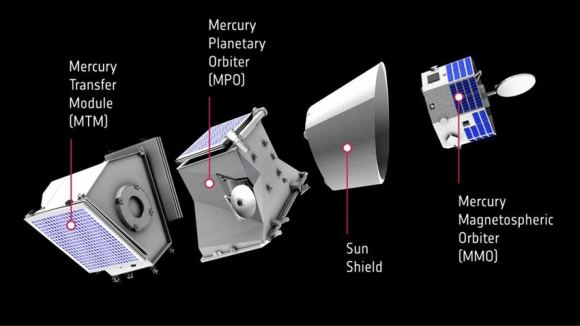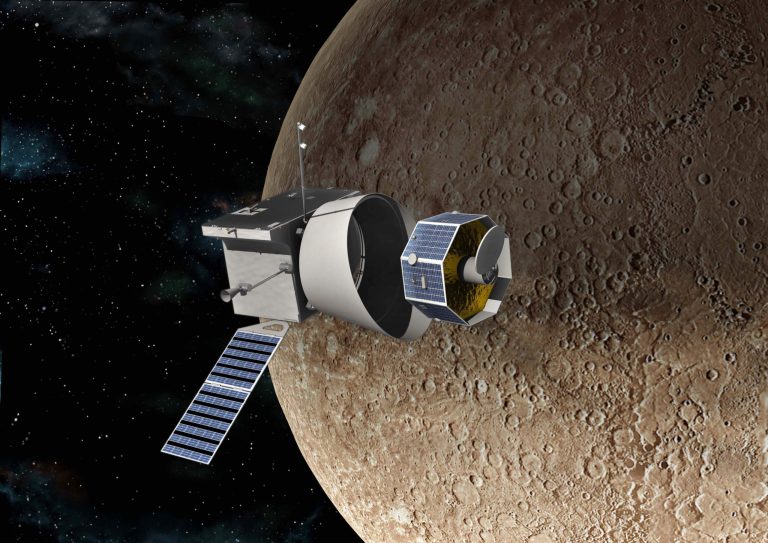Bepicolombo Mission to Mercury
Key Takeaways
BepiColombo is a joint mission by the European Space Agency (ESA) and the Japan Aerospace Exploration Agency (JAXA) to study Mercury. The mission comprises two spacecraft: the Mercury Planetary Orbiter (MPO) and the Mercury Magnetospheric Orbiter (MMO). BepiColombo aims to map Mercury’s surface, analyze its magnetic field, and study its exosphere and core. Launched on October 20, 2018, BepiColombo is expected to arrive at Mercury in 2025. The mission will provide insights into the planet’s formation, geology, and its extreme environment.
Summary
- Joint Mission: Collaboration between ESA and JAXA.
- Spacecraft: Two orbiters – MPO and MMO.
- Launch Date: October 20, 2018.
- Arrival at Mercury: Expected in 2025.
- Mission Goals:
- Map Mercury’s surface.
- Study Mercury’s magnetic field.
- Investigate the planet’s exosphere and core.
- Significance:
- Understand planetary formation.
- Study Mercury’s geology and extreme conditions.
- Scientific Instruments: Includes cameras, spectrometers, magnetometers, and particle analyzers.
- Challenges: High temperatures, intense solar radiation, and gravitational influences.
The BepiColombo Mission to Mercury
The BepiColombo mission is a collaborative effort between the European Space Agency (ESA) and the Japan Aerospace Exploration Agency (JAXA), aiming to explore Mercury, the least explored terrestrial planet in our solar system. Named after Giuseppe “Bepi” Colombo, an Italian scientist who significantly contributed to the study of Mercury, the mission marks a significant milestone in planetary science.
Mission Objectives
The primary objectives of the BepiColombo mission are to:
- Map Mercury’s Surface: High-resolution imaging and spectral mapping to study the planet’s surface composition and geological history.
- Analyze the Magnetic Field: Understanding Mercury’s internal magnetic field and its interaction with the solar wind.
- Study the Exosphere: Investigating the thin, tenuous atmosphere of Mercury.
- Investigate the Core: Gaining insights into the structure and composition of Mercury’s core.
Spacecraft Components
The BepiColombo mission consists of two main spacecraft:
- Mercury Planetary Orbiter (MPO): Built by ESA, the MPO is designed to study Mercury’s surface and internal composition. It carries a suite of instruments including cameras, spectrometers, and a laser altimeter.
- Mercury Magnetospheric Orbiter (MMO): Developed by JAXA, the MMO focuses on studying Mercury’s magnetic environment. It is equipped with magnetometers, particle analyzers, and plasma detectors.

Scientific Instruments
The BepiColombo mission boasts a variety of scientific instruments:
- Cameras: For high-resolution imaging of Mercury’s surface.
- Spectrometers: To analyze the chemical composition of the surface and exosphere.
- Magnetometers: To measure Mercury’s magnetic field.
- Particle Analyzers: To study the composition and dynamics of the exosphere.
- Laser Altimeter: For precise topographic mapping.
Launch and Journey
BepiColombo was launched on October 20, 2018, from the European Spaceport in Kourou, French Guiana, aboard an Ariane 5 rocket. The mission is expected to arrive at Mercury in 2025, after a seven-year journey that includes multiple gravity-assist flybys of Earth, Venus, and Mercury. These flybys are critical for adjusting the spacecraft’s trajectory and reducing its speed for orbital insertion around Mercury.
Challenges of the Mission
Exploring Mercury poses several unique challenges:
- Extreme Temperatures: Mercury’s proximity to the Sun results in surface temperatures ranging from -290°F (-180°C) to 800°F (430°C). The spacecraft must endure these extremes and maintain the functionality of its instruments.
- Intense Solar Radiation: The spacecraft must be protected from the Sun’s intense radiation, which is about ten times stronger than what Earth experiences.
- Gravitational Influences: Navigating the spacecraft to Mercury requires precise calculations to account for the gravitational pull of the Sun and other celestial bodies.
Mission Goals and Scientific Return
The BepiColombo mission is expected to revolutionize our understanding of Mercury. Some key scientific goals include:
- Mapping Mercury’s Surface: The MPO’s high-resolution cameras and spectrometers will create detailed maps of Mercury’s surface, revealing its geological history and surface composition.
- Understanding the Magnetic Field: The MMO will provide valuable data on Mercury’s magnetic field, helping scientists understand its origin and structure.
- Studying the Exosphere: The mission will investigate the composition and dynamics of Mercury’s thin exosphere, offering clues about its interaction with the solar wind.
- Investigating the Core: By studying Mercury’s gravitational field and rotational dynamics, scientists hope to gain insights into the planet’s internal structure and core composition.
Significance of the Mission
The BepiColombo mission holds great significance for planetary science. By studying Mercury, scientists can gain a better understanding of:
- Planetary Formation: Insights into how terrestrial planets, including Earth, formed and evolved.
- Geological Processes: Understanding the geological history and surface processes on Mercury.
- Extreme Environments: Studying how planetary environments close to the Sun are shaped and maintained.
Key Milestones
- 2018: Launch of BepiColombo.
- 2020: First flyby of Earth.
- 2021-2022: Flybys of Venus.
- 2023-2024: Multiple flybys of Mercury.
- 2025: Orbital insertion around Mercury.
Collaborative Efforts
The BepiColombo mission is a testament to international collaboration. ESA and JAXA have pooled their expertise and resources to tackle the formidable challenges of exploring Mercury. This partnership extends to numerous scientific institutions and universities worldwide, which contribute to the mission’s scientific payload and data analysis.

Scientific Instruments Overview
Here is a detailed look at some of the key instruments onboard the BepiColombo spacecraft:
Table 1: Scientific Instruments on MPO
| Instrument | Function |
|---|---|
| Mercury Radiometer and Thermal Imaging Spectrometer (MERTIS) | Maps surface temperature and composition. |
| Mercury Gamma-ray and Neutron Spectrometer (MGNS) | Analyzes elemental composition of the surface. |
| Spectrometers and Imagers for MPO BepiColombo Integrated Observatory SYStem (SIMBIO-SYS) | High-resolution imaging and spectral mapping. |
| Mercury Laser Altimeter (BELA) | Measures surface topography. |
| Italian Spring Accelerometer (ISA) | Measures non-gravitational forces acting on the spacecraft. |
Table 2: Scientific Instruments on MMO
| Instrument | Function |
|---|---|
| Mercury Magnetometer (MMO-MAG) | Studies Mercury’s magnetic field. |
| Plasma Wave Investigation (PWI) | Analyzes plasma waves and their interaction with the magnetic field. |
| Mercury Sodium Atmospheric Spectral Imager (MSASI) | Studies sodium in Mercury’s exosphere. |
| Mercury Dust Monitor (MDM) | Measures dust particles in Mercury’s vicinity. |
| Solar Intensity X-ray and Particle Spectrometer (SIXS) | Monitors solar X-rays and energetic particles. |
Data and Discoveries
The data collected by BepiColombo will be crucial in addressing several unanswered questions about Mercury. For instance, the mission will investigate:
- Surface Features: Detailed mapping to identify geological formations such as craters, cliffs, and volcanic plains.
- Volcanism and Tectonics: Studying evidence of past volcanic and tectonic activity.
- Polar Regions: Investigating the presence of water ice in permanently shadowed craters at Mercury’s poles.
- Magnetosphere Dynamics: Understanding how Mercury’s magnetosphere interacts with the solar wind.
The success of the BepiColombo mission will pave the way for future missions to Mercury and other inner planets. It will also enhance our understanding of exoplanets in close orbits around their parent stars, as these environments can be analogs to Mercury’s extreme conditions.
The BepiColombo mission represents a monumental effort in space exploration and scientific discovery. By delving into the mysteries of Mercury, the mission promises to unlock secrets about the formation and evolution of terrestrial planets. The data gathered will not only expand our knowledge of Mercury but also provide broader insights into planetary science and the conditions that shape our solar system.
Hashtags
#BepiColombo, #MercuryMission, #SpaceExploration, #ESA, #JAXA, #PlanetaryScience, #Mercury, #Astronomy, #SpaceScience, #InterplanetaryMission
References
- European Space Agency: BepiColombo
http://sci.esa.int/bepicolombo/ - Japan Aerospace Exploration Agency: BepiColombo
https://www.isas.jaxa.jp/en/missions/spacecraft/current/mmo.html - National Space Science Data Center Master Catalog: BepiColombo
https://nssdc.gsfc.nasa.gov/nmc/spacecraft/display.action?id=2018-080A - European Space Agency (ESA). (2023). “BepiColombo Mission Overview”. Retrieved from ESA Website.
- Japan Aerospace Exploration Agency (JAXA). “BepiColombo: Mission to Mercury”. Retrieved from JAXA Website.

